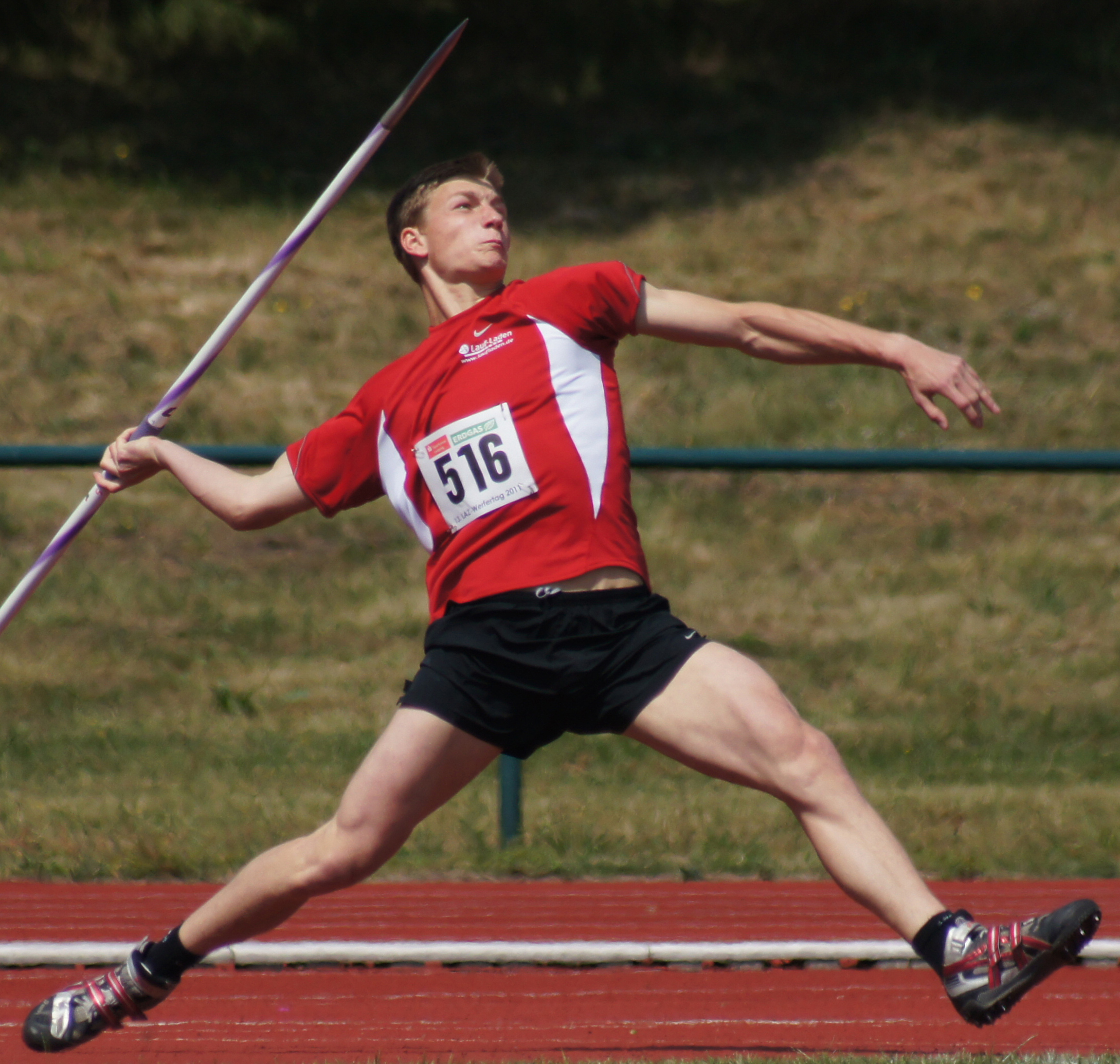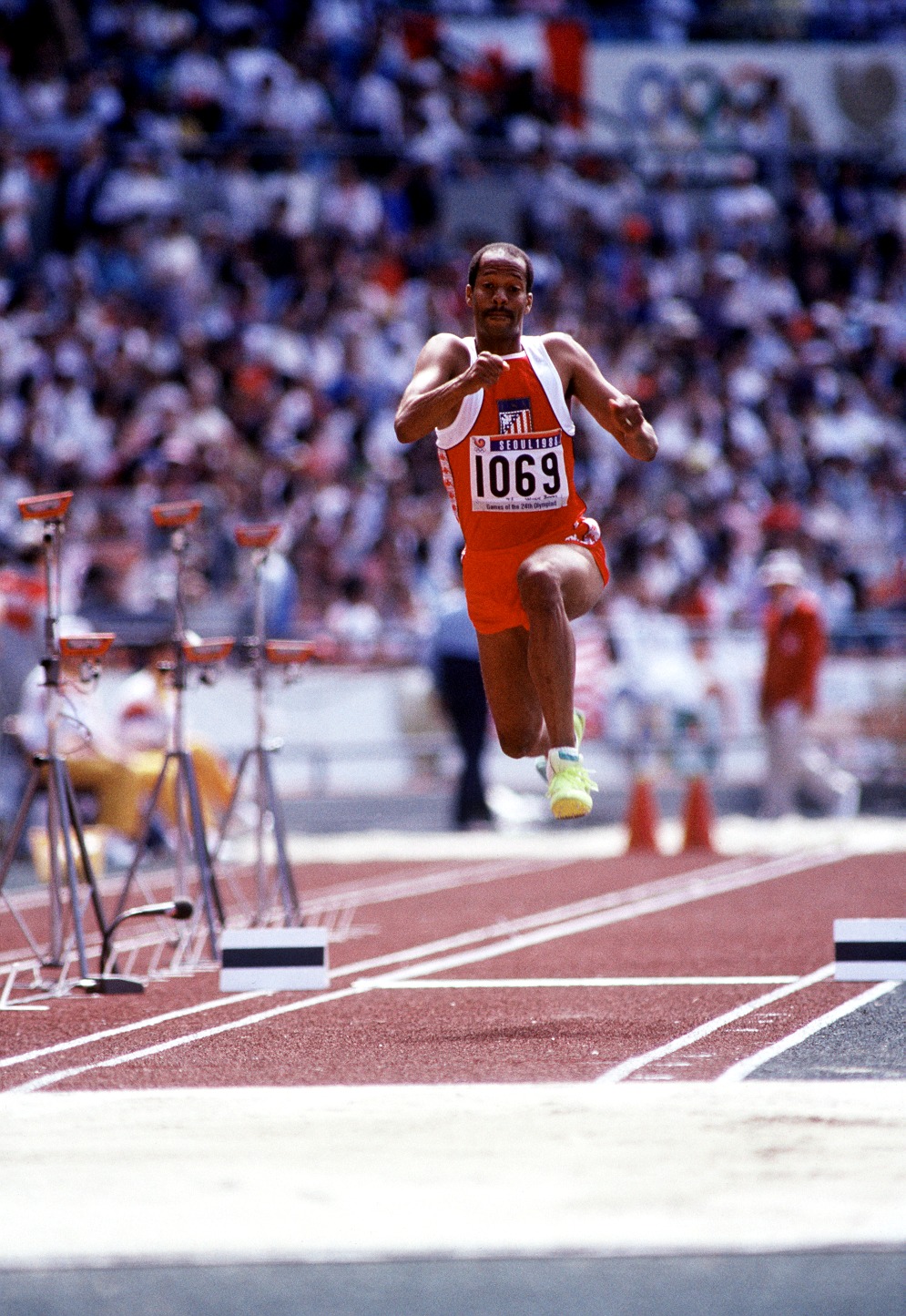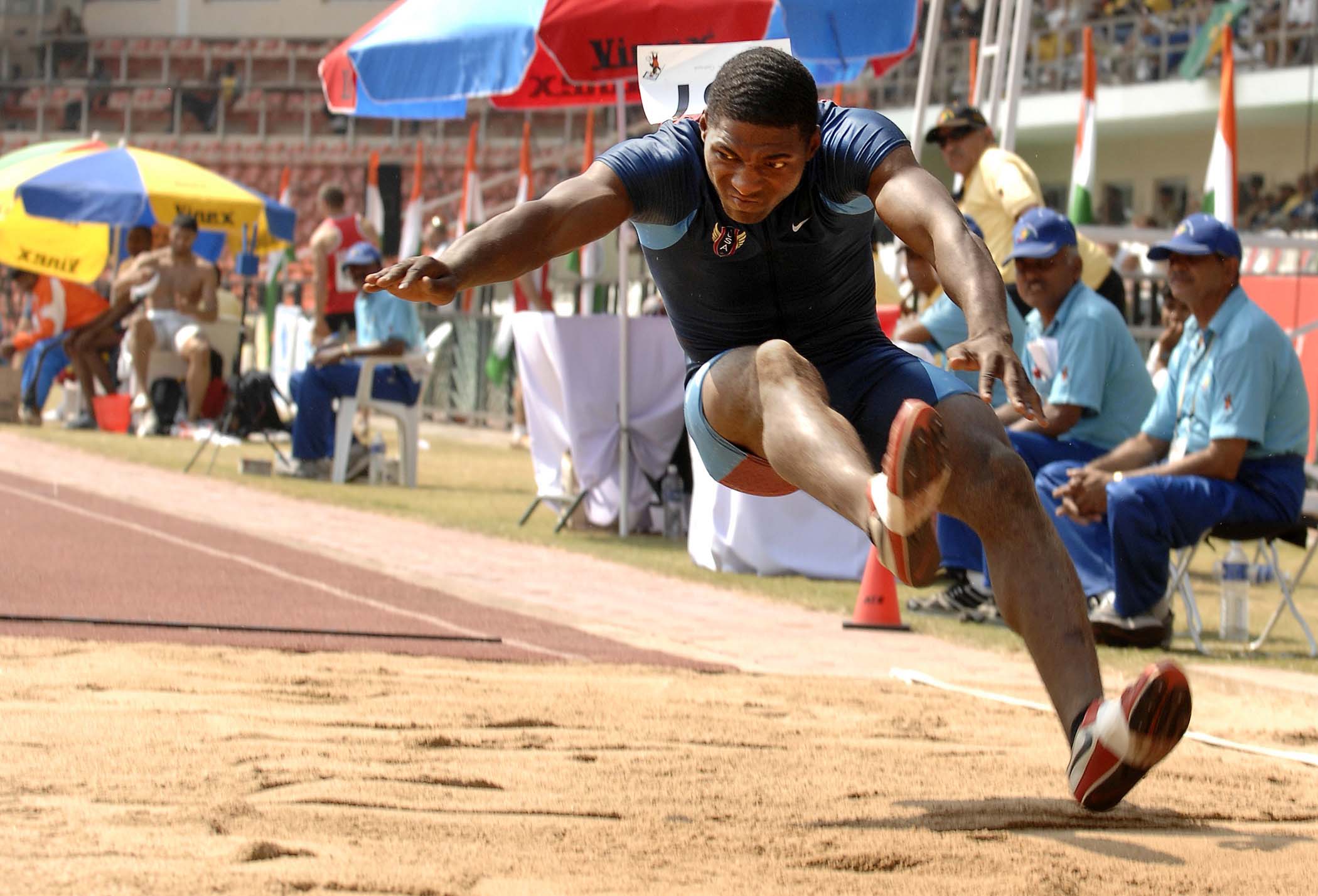|
Adolphus Jones
Adolphus "Dolly" Jones (born 24 July 1984) is a Kittitian and Nevisian track and field athlete and soccer player. In the decathlon he competed for his native country at the 2007 Pan American Games, the 2010 Commonwealth Games, and the Central American and Caribbean Championships in Athletics in 2008 and 2009. He holds several Saint Kitts and Nevis records in athletics, including 7258 points in the decathlon and 5475 points for the indoor heptathlon. He played as goalkeeper for the Saint Kitts and Nevis national football team in two matches for the 2006 FIFA World Cup qualifiers. Career Early life Born in Basseterre, he began taking part in both athletics and soccer as a teenager. At the 2003 Leeward Islands Junior Championships in Athletics he competed in a variety of events, winning medals in the 800 metres, high jump, long jump, triple jump and javelin throw. He entered the 800 m and 1500 metres at the 2003 CARIFTA Games, placing sixth and seventeenth, respectively ... [...More Info...] [...Related Items...] OR: [Wikipedia] [Google] [Baidu] |
Basseterre
Basseterre (; Saint Kitts Creole: ''Basterre'') is the capital and largest city of Saint Kitts and Nevis with an estimated population of 14,000 in 2018. Geographically, the Basseterre port is located at , on the south western coast of Saint Kitts Island, and it is one of the chief commercial depots of the Leeward Islands. The city lies within Saint George Basseterre Parish. Basseterre is one of the oldest towns in the Eastern Caribbean. History Basseterre was founded in 1627 by the French, under Sieur Pierre Belain d'Esnambuc. It served as the capital of the French colony of Saint-Christophe, which consisted of the northern and southern extremities of the island of St. Kitts (the centre was yielded to Britain). When Phillippe de Longvilliers de Poincy was made the French governor of St. Kitts in 1639, the town turned into a large, successful port, commanding Eastern Caribbean trade and colonisation. De Poincy then quickly made Basseterre capital of the entire French West ... [...More Info...] [...Related Items...] OR: [Wikipedia] [Google] [Baidu] |
2006 FIFA World Cup Qualifiers
The 2006 FIFA World Cup qualification competition was a series of tournaments organised by the six FIFA confederations. Each confederation – the AFC (Asia), CAF (Africa), CONCACAF (North, Central America and Caribbean), CONMEBOL (South America), OFC (Oceania), and UEFA (Europe) – was allocated a certain number of the 32 places at the tournament. A total of 197 teams entered the qualification process for the 2006 FIFA World Cup. In 2001 FIFA ended automatic qualification of the reigning champion, so that 2002 champions Brazil became first to participate in the qualifying tournament. The hosts (Germany) retained their automatic spot. The original distribution of places between the six confederations called for Oceania to be given one full spot in the final 32; this idea was seen as virtually guaranteeing a place in the finals to Australia, by far the strongest footballing nation in the region. This decision was reconsidered in June 2003 and the previous distribution of place ... [...More Info...] [...Related Items...] OR: [Wikipedia] [Google] [Baidu] |
2005 Caribbean Cup
The 2005 Caribbean Cup (known as the Digicel Caribbean Cup for sponsorship reasons) was the thirteenth edition of the Caribbean Cup hosted by Barbados and won by Jamaica. In all, 30 countries were invited, of which, 22 participated and 8 withdrew. Qualifying tournament First qualifying round (Group stage) Group A Group A Qualifier: Saint-Martin w/o (Sint Maarten withdrew) Played in Kingston, Jamaica ---- ---- Group B Played in Martinique ---- ---- Group C Group C qualifier: withdrew. Bahamas qualified but they also withdrew; their place was taken by Guyana. The participants were supposed to be: , , , , and the matches were planned to be played in Cuba. However, Netherlands Antilles, Guyana, Dominican Republic all withdrew later, and so Cuba won the group automatically. Group D Group D qualifier: both through . The matches were scheduled to be played on 5 and 11 September but Guyana were requested to replace the Bahamas from Group C who withdrew so Surin ... [...More Info...] [...Related Items...] OR: [Wikipedia] [Google] [Baidu] |
ESPN
ESPN (originally an initialism for Entertainment and Sports Programming Network) is an American international basic cable sports channel owned by ESPN Inc., owned jointly by The Walt Disney Company (80%) and Hearst Communications (20%). The company was founded in 1979 by Bill Rasmussen along with his son Scott Rasmussen and Ed Eagan. ESPN broadcasts primarily from studio facilities located in Bristol, Connecticut. The network also operates offices and auxiliary studios in Miami, New York City, Las Vegas, Seattle, Charlotte, Washington, D.C., and Los Angeles. James Pitaro currently serves as chairman of ESPN, a position he has held since March 5, 2018, following the resignation of John Skipper on December 18, 2017. While ESPN is one of the most successful sports networks, there has been criticism of ESPN. This includes accusations of biased coverage, conflict of interest, and controversies with individual broadcasters and analysts. , ESPN reaches approximately ... [...More Info...] [...Related Items...] OR: [Wikipedia] [Google] [Baidu] |
FIFA
FIFA (; stands for ''Fédération Internationale de Football Association'' (French), meaning International Association Football Federation ) is the international governing body of association football, beach football and futsal. It was founded in 1904 to oversee international competition among the national associations of Belgium, Denmark, France, Germany, the Netherlands, Spain, Sweden and Switzerland. Headquartered in Zürich, Switzerland, its membership now comprises 211 national associations. These national associations must each also be members of one of the six regional confederations into which the world is divided: CAF (Africa), AFC (Asia and Australia), UEFA (Europe), CONCACAF (North & Central America and the Caribbean), OFC (Oceania) and CONMEBOL (South America). FIFA outlines a number of objectives in the organizational Statutes, including growing association football internationally, providing efforts to ensure it is accessible to everyone, and advocating ... [...More Info...] [...Related Items...] OR: [Wikipedia] [Google] [Baidu] |
Mexico National Football Team
The Mexico national football team () represents Mexico in international football and is governed by the Mexican Football Federation (). It competes as a member of CONCACAF. Mexico has qualified to seventeen World Cups and has qualified consecutively since 1994, making it one of six countries to do so. Mexico played France in the first match of the first World Cup on 13 July 1930. Mexico's best progression in World Cups has been reaching the quarter-finals in both the 1970 and 1986 World Cups, both of which were staged on Mexican soil. Mexico is historically the most successful national team in the CONCACAF region, having won eleven confederation titles, including eight CONCACAF Gold Cups and three CONCACAF Championships (the precursor to the Gold Cup), as well as two NAFC Championships, one North American Nations Cup, one CONCACAF Cup and two gold medals of the Central American and Caribbean Games. It is one of eight nations to have won two of the three most importa ... [...More Info...] [...Related Items...] OR: [Wikipedia] [Google] [Baidu] |
2003 CARIFTA Games
The 32nd CARIFTA Games were held in the Hasely Crawford National Stadium in Port of Spain, Trinidad and Tobago on April 19–21, 2003. A detailed report on the results was given. Participation (unofficial) Detailed result lists can be found on the CFPI and the "World Junior Athletics History" website. An unofficial count yields the number of about 427 athletes (219 junior (under-20) and 208 youth (under-17)) from about 23 countries: Anguilla (3), Antigua and Barbuda (15), Aruba (4), Bahamas (64), Barbados (21), Bermuda (7), British Virgin Islands (7), Cayman Islands (13), Dominica (4), French Guiana (2), Grenada (47), Guadeloupe (20), Guyana (15), Haiti (7), Jamaica (70), Martinique (19), Netherlands Antilles (15), Saint Kitts and Nevis (6), Saint Lucia (8), Saint Vincent and the Grenadines (5), Trinidad and Tobago (66), Turks and Caicos Islands (8), US Virgin Islands (1). Records A total of 14 games records were set. In the boys' U-20 category, Usain Bolt from Jamaica set ... [...More Info...] [...Related Items...] OR: [Wikipedia] [Google] [Baidu] |
1500 Metres
The 1500 metres or 1,500-metre run (typically pronounced 'fifteen-hundred metres') is the foremost middle distance track event in athletics. The distance has been contested at the Summer Olympics since 1896 and the World Championships in Athletics since 1983. It is equivalent to 1.5 kilometers or approximately miles. The event is closely associated with its slightly longer cousin, the mile race, from which it derives its nickname "the metric mile". The demands of the race are similar to that of the 800 metres, but with a slightly higher emphasis on aerobic endurance and a slightly lower sprint speed requirement. The 1500 metre race is predominantly aerobic, but anaerobic conditioning is also required. Each lap run during the world-record race run by Hicham El Guerrouj of Morocco in 1998 in Rome, Italy averaged just under 55 seconds (or under 13.8 seconds per 100 metres). 1,500 metres is three and three-quarter laps around a 400-metre track. During the 197 ... [...More Info...] [...Related Items...] OR: [Wikipedia] [Google] [Baidu] |
Javelin Throw
The javelin throw is a track and field event where the javelin, a spear about in length, is thrown. The javelin thrower gains momentum by running within a predetermined area. Javelin throwing is an event of both the men's decathlon and the women's heptathlon. History The javelin throw was added to the Ancient Olympic Games as part of the pentathlon in 708 BC. It included two events, one for distance and the other for accuracy in hitting a target. The javelin was thrown with the aid of a thong ('' ankyle'' in Greek) that was wound around the middle of the shaft. Athletes held the javelin by the ''ankyle'', and when they released the shaft, the unwinding of the thong gave the javelin a spiral trajectory. Throwing javelin-like poles into targets was revived in Germany and Sweden in the early 1870s. In Sweden, these poles developed into the modern javelin, and throwing them for distance became a common event there and in Finland in the 1880s. The rules continued t ... [...More Info...] [...Related Items...] OR: [Wikipedia] [Google] [Baidu] |
Triple Jump
The triple jump, sometimes referred to as the hop, step and jump or the hop, skip and jump, is a track and field event, similar to the long jump. As a group, the two events are referred to as the "horizontal jumps". The competitor runs down the track and performs a hop, a bound and then a jump into the sand pit. The triple jump was inspired by the ancient Olympic Games and has been a modern Olympics event since the Games' inception in 1896. According to World Athletics rules, "the hop shall be made so that an athlete lands first on the same foot as that from which he has taken off; in the step he shall land on the other foot, from which, subsequently, the jump is performed." The current male world record holder is Jonathan Edwards of the United Kingdom, with a jump of . The current female world record holder is Yulimar Rojas of Venezuela, with a jump of . History Historical sources on the ancient Olympic Games occasionally mention jumps of 15 meters or more. This led spo ... [...More Info...] [...Related Items...] OR: [Wikipedia] [Google] [Baidu] |
Long Jump
The long jump is a track and field event in which athletes combine speed, strength and agility in an attempt to leap as far as possible from a takeoff point. Along with the triple jump, the two events that measure jumping for distance as a group are referred to as the "horizontal jumps". This event has a history in the ancient Olympic Games and has been a modern Olympic event for men since the first Olympics in 1896 and for women since 1948. Rules At the elite level, competitors run down a runway (usually coated with the same rubberized surface as running tracks, crumb rubber or vulcanized rubber, known generally as an all-weather track) and jump as far as they can from a wooden or synthetic board, 20 centimetres or 8 inches wide, that is built flush with the runway, into a pit filled with soft damp sand. If the competitor starts the leap with any part of the foot past the foul line, the jump is declared a foul and no distance is recorded. A layer of plasticine ... [...More Info...] [...Related Items...] OR: [Wikipedia] [Google] [Baidu] |
High Jump
The high jump is a track and field event in which competitors must jump unaided over a horizontal bar placed at measured heights without dislodging it. In its modern, most-practiced format, a bar is placed between two standards with a crash mat for landing. Since ancient times, competitors have introduced increasingly effective techniques to arrive at the current form, and the current universally preferred method is the Fosbury Flop, in which athletes run towards the bar and leap head first with their back to the bar. The discipline is, alongside the pole vault, one of two vertical clearance events in the Olympic athletics program. It is contested at the World Championships in Athletics and the World Athletics Indoor Championships, and is a common occurrence at track and field meets. The high jump was among the first events deemed acceptable for women, having been held at the 1928 Olympic Games. Javier Sotomayor (Cuba) is the current men's record holder with a jump of set ... [...More Info...] [...Related Items...] OR: [Wikipedia] [Google] [Baidu] |
_-_Copy.jpg)





